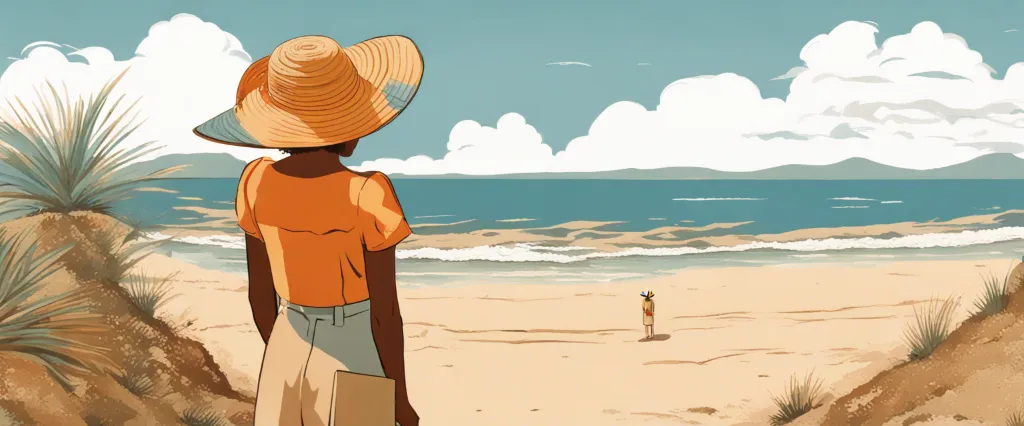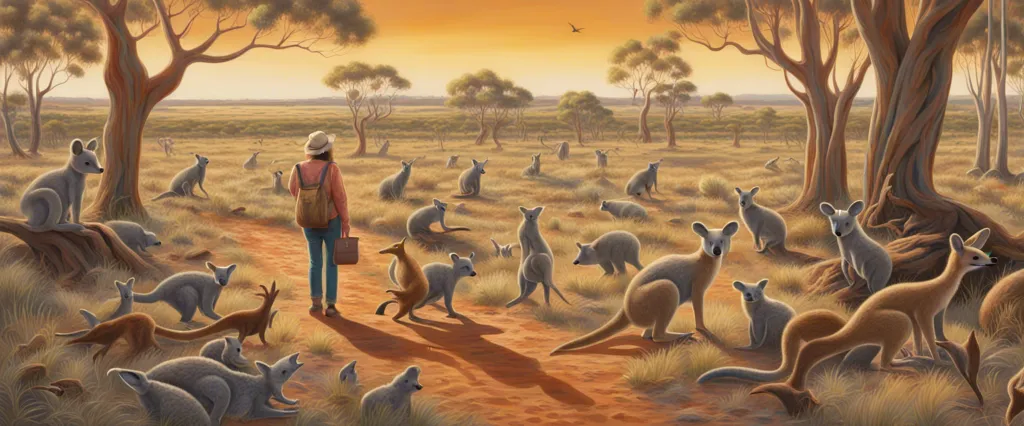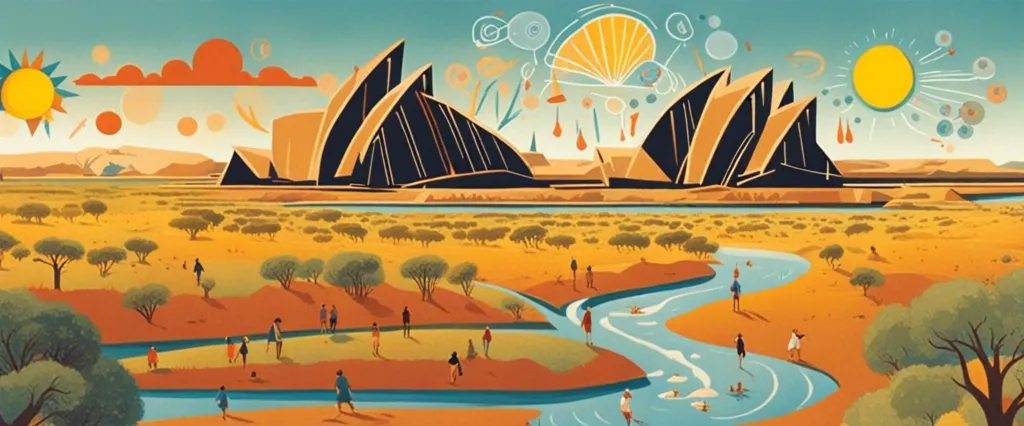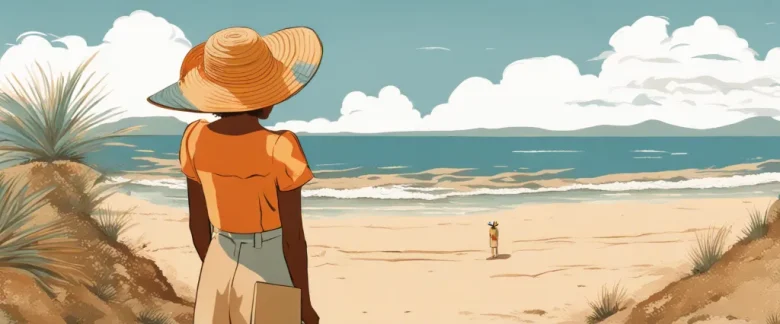
“In a Sunburned Country” by Bill Bryson is a captivating travelogue that takes readers on an unforgettable journey through the fascinating land of Australia. Drawing from his own experiences and extensive research, Bryson sheds light on this vast and remarkable country, unveiling its quirky wildlife, peculiar culture, and breathtaking landscapes. As a renowned author and humorist, Bryson’s unique blend of wit and inquisitiveness provides readers with an engaging exploration of Australia’s distinctive history, geography, and people. Embark on this delightful adventure as Bryson showcases his trademark storytelling abilities, offering a delightful and informative read for both armchair travelers and seasoned explorers alike.
Chapter 1: Land Down Under: Introduction to Australia
Chapter 1 of “In a Sunburned Country” by Bill Bryson, titled “Land Down Under: Introduction to Australia,” is an engaging and humorous introduction to the diverse and mysterious continent of Australia. Bryson begins by acknowledging the geographical isolation of Australia and the enormous scale of its landscape. He describes how Australia is surrounded by large expanses of ocean, making it the world’s largest island and the only country to possess an entire continent.
The author highlights Australia’s unique flora and fauna, emphasizing the country’s unparalleled biodiversity and the numerous species that cannot be found elsewhere. Bryson charmingly recounts his experiences encountering various Australian creatures such as kangaroos, platypuses, and lethal spiders. He also discusses Australia’s infamous wildlife, including its fearsome crocodiles and deadly snakes.
Bryson delves into the history of Australia, starting with the Aboriginal people who inhabited the continent for at least 40,000 years. He acknowledges the tragedy of colonization and the devastating impact it had on the Aboriginal population. Bryson’s storytelling takes readers through the arrival of European settlers, convict colonies, and the ultimate establishment of modern Australia.
The author also explores the fascinating characteristics of Australian cities, such as their immense size and vast tracts of uninhabited land. He discusses the remarkable diversity of the Australian accent, which he humorously describes as a form of “verbal exfoliation.” Bryson further reflects on the cultural differences between Australia and other English-speaking countries, highlighting the country’s laid-back and relaxed way of life.
In summary, Chapter 1 of “In a Sunburned Country” provides readers with an amusing and informative introduction to Australia’s unique geography, remarkable wildlife, rich history, and distinctive culture.
Chapter 2: A Brief History of Australia
Chapter 2: A Brief History of Australia from the book In a Sunburned Country by Bill Bryson provides readers with an overview of Australia’s history, from its ancient Aboriginal roots to the arrival of British settlers.
Bryson begins by discussing the Aboriginal population, which inhabited Australia for at least forty thousand years. He highlights the diverse nature of these Indigenous groups and their deep connection to the land. Bryson acknowledges the tragic impact of British colonization on the Aboriginal people, who faced displacement, violence, and marginalization.
The chapter then delves into the first European contact with Australia by Dutch explorers in the 17th century. Bryson highlights the lack of interest and unwillingness of other European powers to explore the continent, leading to British settlement. He details the arrival of Captain James Cook in 1770, who claimed Australia for Britain, mainly as a penal colony.
Bryson explores the brutal history of convict transportation to Australia, emphasizing the hardship faced by early settlers and the establishment of major cities like Sydney. He also mentions the conflicts between convicts and British authorities, including the famous rebellion of 1804 at the Castle Hill convict station.
The chapter also highlights key events in Australia’s history, such as the gold rush in the mid-1800s, which attracted migrants and contributed to the nation’s economic growth. Bryson touches on the development of the unique Australian accent, formation of Indigenous protection boards, and the participation of Australian troops in various world wars.
Ultimately, the chapter presents an overview of Australia’s complex and sometimes grim history, setting the stage for Bryson’s exploration of the country’s present-day wonders in subsequent chapters.
Chapter 3: Wildlife Wonders and Dangers
Chapter 3 of “In a Sunburned Country” by Bill Bryson delves into the curious and often perilous wildlife of Australia. The chapter begins with an exploration of the Great Barrier Reef and its astonishing variety of marine life. Bryson describes the colorful coral formations and the multitude of fish species, conveying the reef’s immense beauty. However, he also warns of the dangers surrounding the reef, including venomous sea creatures like the box jellyfish and the irukandji jellyfish, which can be lethal to humans.
Moving on to land wildlife, Bryson focuses on the unpredictable nature of Australia’s fauna. He discusses the widespread presence of venomous creatures, such as snakes and spiders, while highlighting Australia’s remarkably high number of venomous animals compared to the rest of the world. Bryson recounts intriguing encounters with various species, including the kangaroo and the famously lethal inland taipan, the most venomous snake on the planet.
Bryson humorously outlines the stark difference between Australian and American wildlife. He expresses disbelief at the number of deadly creatures in Australia, contrasting it with the relatively tame nature of animals in his home country. He also discusses the unique adaptations Australian animals have developed to survive in the harsh environment, such as the kangaroo’s ability to conserve water and the koala’s diet of eucalyptus leaves.
To conclude the chapter, Bryson touches on the destructive impact of non-native species, particularly rabbits and cane toads, on Australia’s ecosystem. He sheds light on the efforts made to control these invasive species, which have had disastrous consequences on native flora and fauna.
Overall, Chapter 3 of “In a Sunburned Country” provides an engaging and informative exploration of the fascinating wildlife that inhabits Australia, while emphasizing the potential dangers one may encounter in this one-of-a-kind ecosystem.
Chapter 4: Exploring the Outback

In Chapter 4 of “In a Sunburned Country” by Bill Bryson, titled “Exploring the Outback,” the author ventures into the vast Australian Outback, where he encounters unique landscapes, diverse wildlife, and remarkable sights.
Bryson starts his journey in Australia’s remote center, Alice Springs, a small town located in the heart of the Outback. He learns about the rich Aboriginal history and the significance of the area’s natural landmarks, such as Uluru (also known as Ayers Rock) and Kata Tjuta (the Olgas).
The author sets off on a challenging road trip to Kings Canyon, driving through vast and desolate landscapes where signs warn of the potential perils of the Outback. He describes the captivating beauty of the scenery, from red sand dunes to ancient rock formations. Along the way, he encounters fascinating wildlife, including kangaroos, emus, and wallabies.
Bryson discusses the hardships faced by early explorers who dared to survive and navigate the harsh Outback conditions. He recounts stories of explorers like Ernest Giles, Peter Warburton, and William Gosse, who charted remote regions and experienced near-impossible challenges.
The author delves into the intriguing world of Aboriginal society, their deep connection to the land, and the secrets they hold about surviving in this harsh environment. He learns about the Dreamtime, the spiritual beliefs and creation stories passed down through generations.
Bryson concludes the chapter by reflecting on the daunting vastness of the Outback, its incredible isolation, and the stark contrast it offers to urban Australia. He underscores the importance of preserving this unique and fragile environment for future generations.
In this chapter, “Exploring the Outback,” Bill Bryson provides his readers with an insightful and engaging account of his adventures in one of Australia’s most captivating and challenging regions, uncovering the ancient history and natural wonders that make the Outback truly remarkable.
Chapter 5: Coastal Adventures and Great Barrier Reef
Chapter 5 of “In a Sunburned Country” by Bill Bryson is titled “Coastal Adventures and Great Barrier Reef.” In this chapter, the author embarks on an exploration of the stunning coastal areas and the remarkable Great Barrier Reef in Australia.
Bryson begins his journey at Port Douglas, a popular tourist destination on the Queensland coast. He is astonished by the beauty of Four Mile Beach, a seemingly endless expanse of pristine white sand. However, he quickly learns about the dangers lurking in the coastal waters. He discovers that the northern Australian beaches are infested with deadly jellyfish such as the box jellyfish and the Irukandji. Bryson vividly describes the measures taken to protect swimmers, including stinger nets and vinegar stations.
Moving on, the author explores the fascinating underwater world of the Great Barrier Reef. He embarks on a tour to dive and snorkel in this spectacular natural wonder. Bryson marvels at the diverse marine life, including colorful corals, giant clams, and abundant tropical fish. He emphasizes the importance of preserving this delicate ecosystem and expresses concerns about the threats it faces due to climate change and pollution.
During his adventures, Bryson encounters another astonishing creature – the saltwater crocodile. He explores the dangers associated with these enormous reptiles and the protective measures necessary for those exploring the northern coast.
In conclusion, Chapter 5 of “In a Sunburned Country” explores the awe-inspiring coastal areas and the significant natural wonder of the Great Barrier Reef. Through his vivid descriptions and personal experiences, Bryson highlights the beauty, dangers, and need for conservation of these stunning environments.
Chapter 6: Australian Cities and Urban Life
Chapter 6 of “In a Sunburned Country” by Bill Bryson explores Australian cities and urban life. Bryson begins by discussing the vastness and emptiness of the Australian continent outside of its cities, highlighting the significant role that cities play in the country. He emphasizes how Australia has a relatively small population compared to its size, with most of its people concentrated in a few major cities.
The chapter focuses on Sydney, Melbourne, Brisbane, and Adelaide, providing an overview of each city’s history, attractions, and unique characteristics. Bryson describes Sydney as the most iconic city in Australia, renowned for its stunning harbor, the Sydney Opera House, and the Sydney Harbour Bridge. Melbourne, on the other hand, is portrayed as a more sophisticated city, known for its vibrant cultural scene and impressive architecture.
Bryson also touches upon Brisbane, which he describes as a relaxed and subtropical city with a thriving arts community. Adelaide is depicted as a beautiful, well-planned city with wide, tree-lined streets and a strong focus on the arts and culture.
Throughout the chapter, Bryson emphasizes the distinctiveness of each city, but also identifies common features shared by Australian cities, such as the abundance of green spaces, outdoor activities, and a general laid-back atmosphere. He also highlights Australia’s deep sporting culture, with cities having numerous sports venues and a strong passion for diverse sporting events.
Overall, Chapter 6 sheds light on the diversity, uniqueness, and significance of Australian cities, portraying them as vibrant cosmopolitan centers within a vast and sparsely populated country.
Chapter 7: Indigenous Culture and Heritage
Chapter 7 of “In a Sunburned Country” by Bill Bryson explores the richness and significance of Australia’s indigenous culture and heritage. Bryson begins by acknowledging the vastness of Australia and its diverse indigenous population, with over 500 distinct language groups.
The chapter delves into the deep history of indigenous Australians, dating back roughly 60,000 years. Bryson discusses their impressive ability to navigate and survive in the harsh Australian outback, relying on their profound understanding of the land, plants, and animals. He highlights the many contributions indigenous Australians have made to modern society, such as the boomerang, ground-dwelling techniques, and unique artistic expressions.
Bryson also discusses the destructive impact of European colonization on indigenous communities and their way of life. He mentions the loss of land, cultural suppression, and the forced removal of children from their families, known as the Stolen Generations, which resulted in long-lasting trauma. Despite these hardships, Bryson explains that indigenous culture remains resilient and deeply rooted.
The author emphasizes the importance of respecting and preserving indigenous culture and heritage. He visits various places, such as the Dampier Peninsula and Kakadu National Park, to learn more about indigenous traditions, rock art, and Dreamtime stories that provide insight into their spiritual beliefs and connection with the land.
In conclusion, Chapter 7 highlights the immense historical and cultural significance of Australia’s indigenous population. It encourages readers to appreciate and honor the rich heritage and contributions of indigenous Australians while recognizing the challenges they face due to the legacy of colonization.

Chapter 8: Farewell to the Land of Oz
Chapter 8: Farewell to the Land of Oz of the book “In a Sunburned Country” by Bill Bryson marks the end of his journey in Australia. As Bryson prepares to depart, he reflects on the experiences and unique aspects of the country he has come to know and love.
The chapter begins with Bryson bidding farewell to his friend and travel companion, Carl. Despite their occasional disagreements, he acknowledges the importance of having someone to share the adventures with and appreciates Carl’s presence throughout the trip.
Reflecting on his time in Australia, Bryson marvels at the vastness and emptiness of the country. He describes the sheer size of the continent, its remote and untouched landscapes, and the extraordinary variation in climate and geography. The ever-present danger of bushfires is highlighted, demonstrating the harsh realities faced by Australians. Yet, despite these challenges, Bryson recognizes their resilient spirit and their ability to adapt to the extreme environment.
Bryson also emphasizes the unique wildlife of Australia, for which it is famous worldwide. He fondly recalls encountering various extraordinary creatures, such as kangaroos, wallabies, and the elusive platypus, among others. The richness and diversity of Australia’s flora and fauna have captivated him and left a lasting impression.
Finally, Bryson takes the time to appreciate the warmth and friendliness of Australians. He acknowledges the relaxed and laid-back nature of the people, their love for sports, the compulsory egalitarianism, and their unique sense of humor.
As Bryson concludes his journey, he expresses his gratitude for the countless experiences and memories he has gathered during his time in Australia. He leaves with a deep appreciation for the country, its people, and the extraordinary wonders it has to offer.
After Reading
In conclusion, “In a Sunburned Country” by Bill Bryson is a fascinating and humorous account of the author’s journey through Australia. Through his witty observations and engaging writing style, Bryson brings to life the unique landscapes, wildlife, and culture of this vast and diverse country. From his encounters with dangerous creatures and unpredictable weather to his exploration of the Aboriginal culture and historical sites, Bryson’s travel memoir provides readers with a vivid and entertaining picture of Australia. Overall, this book is a delightful and informative read for anyone intrigued by the wonders of the Land Down Under.
1. Educated” by Tara Westover: This memoir is a gripping account of a woman’s journey from growing up in a strict and abusive household in rural Idaho to eventually escaping and pursuing an education. It explores themes of resilience, personal growth, and the transformative power of education.
2. “The Kite Runner” by Khaled Hosseini: Set against the backdrop of Afghanistan, this novel tells an emotional story of friendship, betrayal, and redemption. It follows the lives of two young boys, Amir and Hassan, and delves into the consequences of their choices and the impact of the turbulent political climate on their lives.
3. The Alchemist” by Paulo Coelho: This allegorical novel follows the journey of Santiago, a young shepherd in search of his personal legend. The book beautifully captures the essence of self-discovery, fate, and the pursuit of one’s dreams, leaving readers inspired to follow their hearts and pursue their own life’s purpose.
4. “To Kill a Mockingbird” by Harper Lee: A timeless classic, this Pulitzer Prize-winning novel deals with themes of racial injustice, innocence, and the moral growth of its young protagonist, Scout. Set in the 1930s in a small Alabama town, it challenges societal norms and provides a poignant reflection on compassion and empathy.
5. “The Book Thief” by Markus Zusak: Set in Nazi Germany, this novel tells the story of Liesel Meminger, a young girl who finds solace in books amidst the horrors of World War II. Narrated by Death, it explores the power of words, resilience, and the importance of compassion even in the darkest of times.



